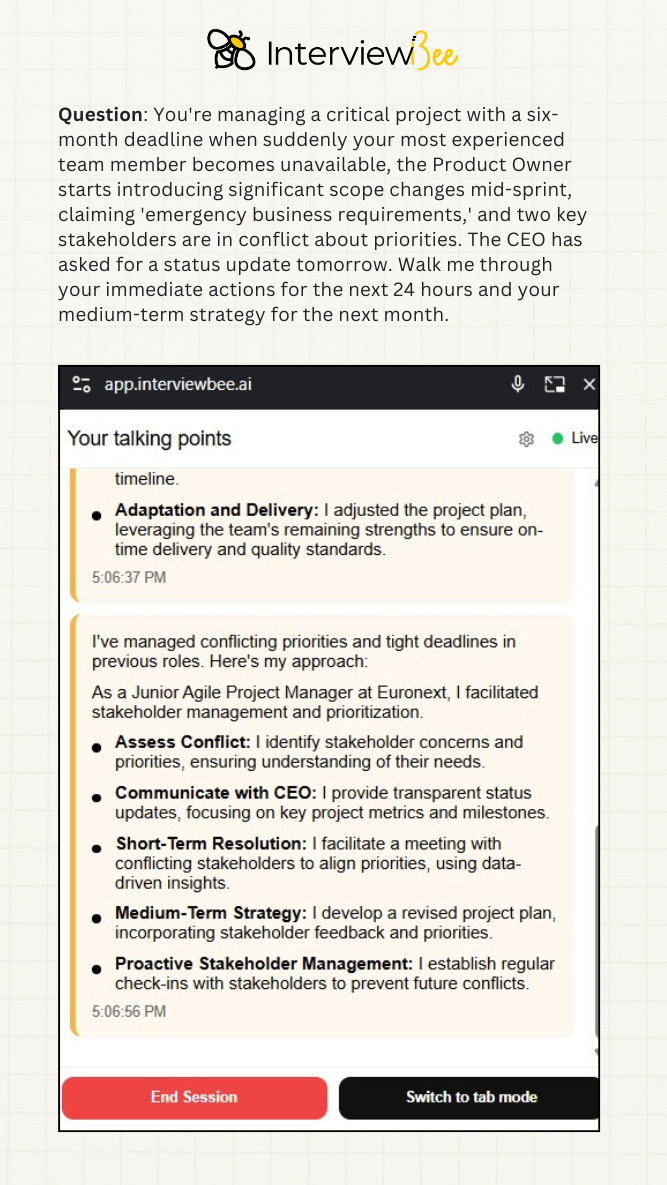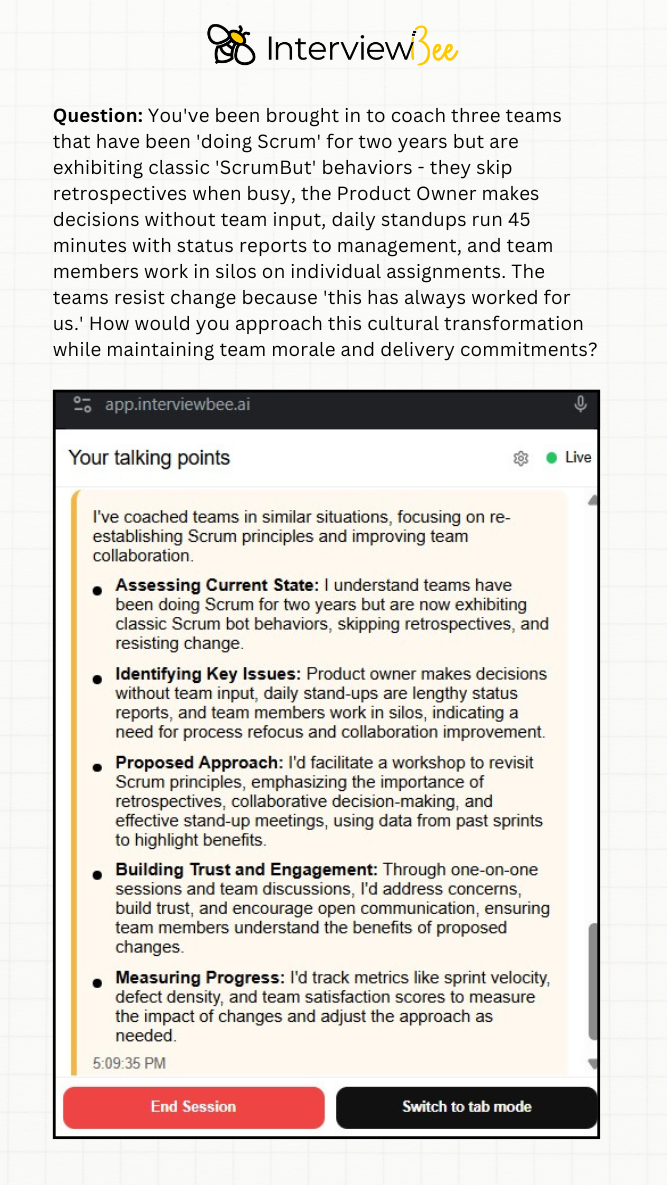
Top 5 Agile Project Manager Interview Questions & Answers
- Author: Anindita Ghosh
- Published On: Aug 27, 2025
- Category:Interview Guide
Landing your dream Agile Project Manager role requires more than just knowing Scrum ceremonies and Agile principles. Today's agile project manager interview process has evolved significantly, requiring comprehensive project management interview prep to succeed. Today's agile project manager interview sessions feature complex, scenario-based questions that test your ability to navigate real-world challenges while maintaining Agile values. Here are the most challenging scrum master interview questions you're likely to encounter – and more importantly, how to answer them using the proven STARR framework.
The STARR method (Situation, Task, Action, Result, Reflection) provides a structured approach to showcase your experience and problem-solving abilities in a way that resonates with agile project manager interview panels at all levels.
Question 1: Managing Organizational Resistance and Stagnation
This challenging agile project manager interview question tests your change management capabilities:
The Question: "Imagine a scenario where a well-established team has been using agile practices for several years but is now experiencing stagnation in delivery and team morale. Additionally, senior leadership is resistant to further Agile transformation initiatives and questions the ROI of Agile practices. How would you diagnose the root causes, address leadership concerns with concrete business metrics, and lead the team towards renewed success while managing organizational politics?"
STARR Framework Answer:
Situation: I encountered this exact scenario at my previous company where three Agile teams had been operating for two years but were showing declining velocity (down 30% over six months), increasing defect rates, and low team satisfaction scores. Senior leadership was questioning the value of our Agile investment, particularly after seeing increased operational costs.
Task: My task was to diagnose the root causes of stagnation, rebuild leadership confidence in Agile practices, and revitalize team performance while navigating organizational politics and budget constraints.
Action: I implemented a three-phase approach:
Phase 1 - Comprehensive Diagnosis: I conducted team happiness surveys, analyzed velocity trends over 18 months, and performed one-on-one interviews with team members. This revealed "Agile plateau syndrome" - teams had mastered ceremonies but lost sight of underlying principles.
Phase 2 - Leadership Engagement: I created a business-focused presentation showing the cost of quality issues ($2.3M annually in rework), time-to-market delays compared to competitors, and customer satisfaction correlation with revenue. I translated Agile benefits into financial terms that executives understood.
Phase 3 - Renewal Strategy: I proposed a 90-day improvement initiative focused on value stream mapping, technical debt reduction, and reintroducing servant leadership principles through targeted coaching.
Result: Within three months, we achieved a 25% improvement in delivery velocity, reduced defect rates by 40%, and improved team satisfaction scores from 2.8 to 4.1 out of 5. Leadership renewed their commitment to Agile transformation after seeing concrete ROI metrics.
Reflection: This experience taught me that Agile stagnation often stems from mechanical adherence to processes without understanding the underlying values. The key to managing organizational resistance is speaking the language of business value rather than Agile terminology, and always backing recommendations with data-driven insights. This type of project management interview prep scenario is common in senior-level positions.
Question 2: Crisis Management Under Extreme Pressure
Another frequently asked agile project manager interview challenge focuses on crisis leadership:
The Question: "You're managing a critical project with a six-month deadline when suddenly your most experienced team member becomes unavailable, the Product Owner starts introducing significant scope changes mid-sprint claiming 'emergency business requirements,' and two key stakeholders are in conflict about priorities. The CEO has asked for a status update tomorrow. Walk me through your immediate actions for the next 24 hours and your medium-term strategy for the next month."
STARR Framework Answer:
Situation: During a high-visibility customer portal redesign project, we lost our lead developer to a family emergency just as the Product Owner began introducing major scope changes due to new regulatory requirements. Meanwhile, our Sales VP and Operations Director had conflicting priorities about which features to prioritize first.
Task: I needed to assess project impact, manage stakeholder conflicts, provide clear options to executive leadership, and maintain team morale while keeping the project on track for a hard deadline.
Action: I executed a structured 24-hour crisis response:
Hours 1-4: Convened emergency team assessment to document current sprint state and identify critical dependencies. Conducted separate one-on-one calls with conflicting stakeholders to understand their underlying concerns without public confrontation.
Hours 5-12: Created three scenario models for the CEO: maintain scope with adjusted timeline, reduce scope to meet deadline, or accelerate with additional resources. Simultaneously explored resource contingencies including knowledge transfer protocols and contractor options.
Hours 13-24: Prepared executive summary focusing on business impact, recommended path forward with clear trade-offs, and outlined immediate risk mitigation steps.
Result: The CEO chose the hybrid approach - we brought in a contractor for knowledge transfer, negotiated a two-week timeline extension, and implemented a formal change control process. The project delivered successfully with 95% of original scope and only a 10% budget increase.
Reflection: Crisis management in Agile environments requires rapid assessment, transparent communication, and options-based decision making. The key is maintaining Agile principles (transparency, collaboration, adaptation) while providing executives with the business-focused information they need to make informed decisions quickly.

Question 3: Complex Metrics Analysis and Performance Optimization
This analytical scrum master interview questions category tests your data interpretation skills:
The Question: "Your team has been running two-week sprints for eight months. Velocity has been declining over the last three sprints (from 45 to 38 to 32 story points), lead time has increased by 40%, and team satisfaction scores dropped from 4.2 to 2.8 out of 5. However, the Product Owner reports that delivered features have 60% fewer bugs than six months ago. Analyze what might be happening, propose specific metrics you would track, design experiments to test your hypotheses, and present how you would communicate these findings to different stakeholder groups."
STARR Framework Answer:
Situation: I faced this exact scenario with a development team that was showing contradictory performance indicators - declining speed and morale but dramatically improved quality. The team was caught in what I recognized as a quality-vs-speed optimization trap.
Task: I needed to diagnose the root cause of this performance paradox, design data-driven experiments to validate hypotheses, and create stakeholder-specific communication strategies to address different concerns.
Action: I implemented a comprehensive analysis framework:
Hypothesis Development: I proposed three theories - the team had shifted to "perfection-focused" behavior due to past quality criticism, technical debt was accumulating and slowing development, or team burnout was affecting productivity while remaining effort focused on quality.
Metrics Framework Implementation: I established flow metrics (cycle time breakdown, WIP limits), quality metrics (escaped defect rates, technical debt ratio), team health metrics (workload distribution, psychological safety), and value metrics (customer satisfaction, business value delivered).
Experimental Design: I ran four parallel experiments over two weeks - process overhead analysis, technical debt impact assessment, quality gate analysis, and team capacity/motivation study.
Result: The experiments revealed that new quality gates introduced six months prior were consuming 35% of development time, and the team had overcorrected on quality due to previous criticism. We rebalanced the approach, achieving a 20% improvement in velocity while maintaining the improved quality standards.
Reflection: This taught me that declining velocity doesn't always indicate poor performance - sometimes it reflects system optimization for different outcomes. The key is using multiple metrics to understand the full story and designing experiments to validate assumptions before making changes.
Question 4: Cultural Transformation and Team Resistance
Cultural change scenarios are essential scrum master interview questions in any comprehensive project management interview prep:
The Question: "You've been brought in to coach three teams that have been 'doing Scrum' for two years but are exhibiting classic 'ScrumBut' behaviors - they skip retrospectives when busy, the Product Owner makes decisions without team input, daily standups run 45 minutes with status reports to management, and team members work in silos on individual assignments. The teams resist change because 'this has always worked for us.' How would you approach this cultural transformation while maintaining team morale and delivery commitments?"
STARR Framework Answer:
Situation: I was brought into a traditional manufacturing company where three development teams had adopted Scrum ceremonies but not the underlying cultural principles. They exhibited classic "mechanical Scrum" behaviors and strongly resisted changes to their established patterns.
Task: I needed to transform the culture from command-and-control to collaborative self-organization while maintaining productivity and team buy-in throughout the transition.
Action: I implemented a four-phase transformation strategy:
Phase 1 - Agile Archaeology: Rather than telling teams what was wrong, I facilitated sessions where they identified their own pain points through guided reflection. I asked questions like "What would happen if we could reclaim 30 minutes from daily standups?" to create intrinsic motivation for change.
Phase 2 - Safe-to-Fail Experiments: I introduced changes as temporary experiments with clear exit strategies - "Let's try 15-minute standups focused on impediments for two weeks" or "What if the team voted on next user story prioritization?"
Phase 3 - Value Demonstration: As experiments showed positive results, I helped teams connect the dots between Agile practices and outcomes they cared about - less overtime, clearer priorities, reduced context switching.
Phase 4 - Sustainable Integration: Successful experiments became permanent practices through team decision-making rather than coaching mandate.
Result: Over 12 weeks, all three teams voluntarily adopted true Agile practices. Delivery velocity increased by 15%, team satisfaction improved significantly, and retrospectives became their most valued ceremony for continuous improvement.
Reflection: Cultural transformation requires patience and cannot be mandated. The most effective approach is helping teams discover the benefits of Agile practices through their own experience rather than imposing change from outside. Resistance typically indicates fear of loss of control or competence.

Question 5: Technical Debt and Quality Conflicts
The Question: "Your development team is pushing back against sprint commitments, claiming they need to spend 60% of each sprint addressing technical debt. The Product Owner is frustrated because new features are barely being delivered, and customer satisfaction is declining due to slow feature delivery. Business stakeholders are threatening to bring in an external team to 'speed things up.' How do you facilitate this three-way conflict, establish sustainable technical debt management practices, and maintain team autonomy while meeting business expectations?"
STARR Framework Answer:
Situation: I encountered this crisis at a fintech startup where years of rapid development had created massive technical debt. The development team was spending 60% of their time on maintenance, the Product Owner was frustrated with slow feature delivery, and executives were considering replacing the entire development team.
Task: I needed to facilitate a three-way conflict between technical needs, business requirements, and stakeholder expectations while establishing sustainable practices that balanced speed and quality.
Action: I implemented a structured resolution approach:
Data-Driven Facilitation: I organized a joint session with all stakeholders using objective data - current time allocation, specific examples of how technical debt slowed feature development, customer impact analysis, and cost comparisons of continuing versus investing in debt reduction.
Visual Understanding: I used value stream mapping to show non-technical stakeholders how technical debt created delays throughout the development process, making the invisible costs visible.
Option Modeling: I presented three scenarios with clear trade-offs - status quo with predictable decline, "big bang" debt reduction with no features, and sustainable integrated approach.
Framework Implementation: I established the "20% rule" - 20% of each sprint reserved for technical debt as non-negotiable infrastructure maintenance, plus a debt prioritization matrix based on business impact, development velocity impact, risk assessment, and effort estimation.
Result: We implemented the sustainable approach and within four months reduced technical debt by 40% while maintaining 80% feature delivery capacity. Customer satisfaction improved due to both new features and better system reliability. The external team threat was eliminated.
Reflection: Technical debt conflicts often stem from lack of shared understanding between technical and business stakeholders. The key is translating technical concepts into business language and establishing sustainable practices that prevent future accumulation rather than just addressing current symptoms.
Key Patterns for Success
These five agile project manager interview questions represent the evolution of Agile Project Management roles from ceremonial facilitators to strategic business partners. Successful candidates demonstrate:
- Multi-dimensional thinking - ability to balance technical, business, and human considerations simultaneously
- Data-driven decision making - using metrics and experiments to guide actions rather than assumptions
- Stakeholder translation - converting between technical and business languages effectively
- Change management skills - facilitating transformation while maintaining productivity and morale
- Business acumen - understanding financial impact and strategic positioning of Agile practices
Mastering the STARR Framework for Agile Interviews
The STARR framework is particularly powerful for any agile project manager interview because it demonstrates:
- Situation shows your experience with real-world complexity
- Task reveals your ability to identify priorities and scope challenges appropriately
- Action demonstrates your methodology and problem-solving approach
- Result provides concrete evidence of your impact and effectiveness
- Reflection shows continuous learning mindset essential for Agile success
Remember, these questions test not just your Agile knowledge but your ability to apply that knowledge in complex, multi-stakeholder environments while maintaining the human-centered values that make Agile transformation successful.
Practice with InterviewBee
Master Agile Project Manager interview questions with InterviewBee's AI tools designed specifically for project management professionals preparing for complex scenario-based interviews:
- Mock AI Interviewer: Practice realistic Agile scenarios and get feedback on your STARR framework responses across all five challenging scrum master interview questions
- Live AI Assistant: Get real-time support during actual agile project manager interview sessions with instant talking points for complex stakeholder situations and technical discussions
- Performance Analytics: Track improvement across different Agile competencies - from metrics analysis to cultural transformation - over time, making your project management interview prep more effective
Final Tips for Your Interview
- Prepare real examples: Each STARR answer should be based on actual experience, not theoretical knowledge
- Practice metrics: Be ready to discuss specific numbers and measurements from your experience
- Show progression: Demonstrate how you've grown in complexity and responsibility over time
- Balance perspectives: Show ability to understand and address concerns of different stakeholder groups
- Emphasize learning: Agile is about continuous improvement - show how you learn from both successes and failures
These questions reflect the reality that modern Agile Project Managers are strategic leaders who drive organizational transformation while maintaining technical excellence and team effectiveness. Mastering these scenarios will position you not just to pass the interview, but to excel in the role itself.


